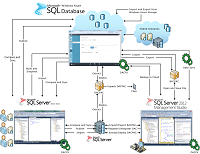Microsoft Ramps Up Database Lifecycle Management Guidance
Need help troubleshooting a Windows Azure SQL Database connection, or getting started with SQL Server Data Tools? Well, there's now a one-stop shop where you can identify aspects of your problem as it relates to the big picture of database development and immediately go to the appropriate resources to solve it.
Yes, data developers now have their own lifecycle management acronym and accompanying guidance.
That's thanks to Microsoft's Louis Berner and his Database Lifecycle Management topic page in the MSDN Library.
"DLM is not a product but a comprehensive approach to managing the database schema, data, and metadata for a database application," the page states. It includes a complicated diagram (see Figure 1) that developers can use to identify apps and actions specific to their scenarios, along with links for guidance in the categories SQL Server Data Tools, SQL Server Management Studio and Windows Azure SQL Database.

[Click on image for larger view.] |
| Figure 1. The DLM Diagram |
I asked Berner about his DLM topic page, which has been getting some buzz in data development circles since it went live around the end of January. He explained that he worked in SQL Server Education, collaborating with Microsoft Customer Support Services to spot trends in customer support calls and resolve problems.
Last summer, he identified several issues in his bailiwick: SQL Server and SQL Database (Azure) manageability. He listed them as:
- Customers were frustrated in their efforts to get started with the Windows Azure platform.
- Data portability was a specific area that stood out as problematic, especially as it relates to service-level agreements, for example, backup/restore, business continuity and disaster recovery.
- Connectivity and troubleshooting connection issues were topics of concern.
- Understanding basic concepts was lacking in terms of what Microsoft offers for database development, portability and monitoring across scenarios that include on-premise, hybrid and cloud architectures; I described it in general terms as "Database Lifecycle Management."
"Customer frustration was understandable because we had developed features and tools over the course of many releases and a time span of five years or more," Berner explained. "Many resources within feature teams didn't understand the holistic view because they worked on individual pieces of the puzzle, and many were recent arrivals to the product unit. Because of their focus on individual features, they weren't expected to understand the big picture."
One particularly important issue he wanted to emphasize was data-tier applications. "Developers can benefit from use of data-tier applications features to create a package for deployment to production, to create a snapshot of a schema for version control, or to publish a schema update in a controlled manner," he said. "This provides developers the ability to cleanly hand off to DBA or Ops resources. The data-tier application is an under-used and under-appreciated feature, in my opinion, maybe because customers don't know about it."
Well, if you didn't know about it, you do now--and you know where to go to learn more. Berner says he will continue to improve on the DLM page. "As I continue to monitor [Customer Support Services] data and other sources of customer experience, I have developed a backlog of additional topics to include in a topic refresh. I will also iterate on the artwork to improve it. Eventually, I would like customers to be able to drill down through the diagram to get to the content they want."
Berner has received good comments on his project and would like to get more feedback from data developers to help him in his improvement process. So check out the page and let him know what you think in the comments section or by sending him an e-mail with the subject: "DLM topic on MSDN."
We'd like to hear from you, too. Please comment here or drop me a line.
Posted by David Ramel on 04/17/2013